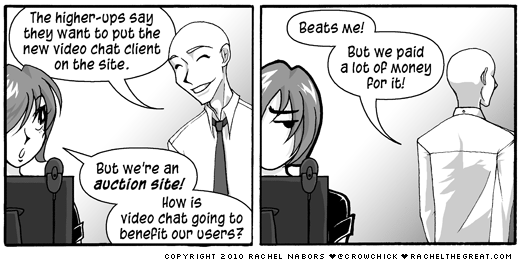Collaborating effectively can be difficult for large companies. Projects can involve multiple locations, people, systems, and other outside companies. Large companies also tend to be departmental rather than project-focused, and this can hinder working together. But, being able to bring people together is key to delivering successful sites for large companies. Here are some tools and techniques to improve collaboration on projects.
A shared vision: the coordinating force
The responsibility of managing the internal land grab for real estate of the site falls to the online team. Empathy for this team is important to working well together. Although not a design problem, agencies can do more to help to bring people of the project together.
People work best together when they share the same goal, but project goals are often not shared, are overly complicated, or are too specific or irrelevant. In order for people to share the same goal, they need to all understand it. Financial goals help the financial team, just as technical goals help the technical team, but neither of these goals help the marketing, sales, or customer services teams.
It’s important not to focus on the goals of individual departments and instead recognize that people empathize with other people. For this reason, a simple definition of the experience people will have on the site brings people together nicely. Used effectively, this vision of the experience for the site is the thing that can be the coordinating force behind the design of. The vision should answer two questions:
- 1: What is the purpose of the site?
- 2: What kind of experience would matter most to the people using the site?
Here’s another example from my days at Telewest Broadband (now Virgin Media) when tasked with improving the experience for their digital TV customers. We used a reactionary, but accurate vision of what the experience should be: simple, stable, and fast. This statement proved invaluable in what was an eighteen-month project involving thousands of employees and 1.5 million customers.
Nine months in, I sat with a talented team of developers rewriting every line of code on a set top box to accommodate the new features as well as improve the old. When a question arose, developers would ask what they should do. We would simply ask if what they were doing would result in the experience being simpler, stabler, or faster. If it didn’t, then we would not do it! This is just one example where an experience vision not only brought people together, but also helped make decisions.

Illustration provided by Rachel Nabors
For more on experience visions, read Cindy Chastain’s article on Boxes & Arrows called Experience Themes. It explains how a storytelling method can help unify teams and create better products. See also The Experience Vision, by Jared Spool. (Ed: See also Telling Your Website’s Story with Sketchboarding)
Don’t choose sides; avoid company politics
Politics are difficult to avoid when working for large companies. The best approach is to know the political landscape, particularly where it affects your ability to do your job, but remain focused on the job at hand and never get involved. It’s easy to get sucked in but:
- The effects are felt much more by people in the company.
- Being on the outside, you cannot affect the politics of the company.
- Politics should never impact the design.
- Be prepared to stand up for what’s right in the face of obvious political decisions which inhibit your ability to do you job.
Negative company politics
There are two types of company politics: positive and negative. We need to be particularly understanding of negative company politics. Learn to recognize them as they can cause negative work environments that are fraught with fear for the people in the company — fear that they will step on a career grenade or lose their job, for example. The best approach is to not take sides but instead be aware, understanding, and sympathetic, all while remaining focused on the job at hand.
Here are some tips for handling negative company politics:
- Don’t take sides.
- Listen to complainers, but don’t let them dominate.
- Remember who you work for, and keep in contact with your colleagues at the agency to help you keep perspective.
- Don’t mix business with pleasure.
- If it gets really bad, remove yourself from the situation.
- Remain focused on the job.
Workshops are not just for presentations
Workshops and all face-to-face meetings are priceless, particularly initially. As well as helping to build a picture of the people you are working with (see How to Identify and Deal with Different Types of Clients, by Robert Bowen), they are a place to visualize ideas and get consensus. Periodic, well-organized workshops are key to good collaboration and successful projects. But, workshops are not just a place for presentations; they can be the incubus of innovation and expertise sharing. Here are some fundamentals to get right before a workshop takes place:
- Come with a plan and appropriate stimuli.
- You will only get out what you put in, so prepare.
- Have the right people in the room.
- Book workshops early. Large companies have meeting cultures, resulting in busy schedules.
- Ask people to come prepared. As well as an agenda, circulate a short list of questions the workshop will answer.
Solving problems with pictures
Whether it’s a technical process flow or a concept for a page design, if you can visualize your ideas, clients will understand you better. Large companies are not great at visualizing ideas, and it’s what we do best, so don’t hold back. You will find much higher levels of engagement just from doodling rather than writing your ideas.
For some useful reading to encourage sharing ideas and collaboration, check out Sketching communicates ideas, by Jason Robb, and The back of the Napkin, by Dan Roam.
Compiling feature lists as requirements
Designing to the needs of the people who will use the site avoids a common pitfall: collecting features as requirements. Large companies excel at gathering features as requirements. Designing to a list of features results in poor sites, simply because you are not considering the needs of the people who will use the site.
To avoid the collection of feature lists, ask clients to first consider the needs of the people who will use the site. Using this approach will help in the initial conversations to guide the client toward a more holistic view of what is required to meet the objectives. Additionally, it tends to increase design possibilities by not having to design around features in this way.
Technology for technology’s sake
Another potential pitfall is that large companies often focus on their technical capabilities rather than on what people want from the site or how to beat competitors. This is mainly because they invest hugely in these capabilities and want to see a return on their investment. This is problematic, because technology will change. To avoid this, help clients understand that people’s behaviour, rather than technology, makes a much better target, because it is slower to change.
Compromise
We’re all familiar with the story; both you and your client have the best intentions at the start of a project, but practicalities adversely affect your combined best efforts. Compromise can play a bigger part in what we do than we sometimes admit. Nobody likes compromise, but when working with large companies, sometimes it’s unavoidable.
Some years ago, I learned a valuable lesson about compromise. I was working as the customer experience guy for a multinational company delivering a digital TV service. At the beginning of the project, I presented to the Group Director, a man responsible for 5,000 people. Having painted a rosy picture for customers from start to finish, I was surprised with his reaction. He suggested that my picture was right, but wrong for this large company. I was advised to change my approach away from perfection at every point to excellence at the points that really mattered to customers and versus competitors.
This was a real eye-opener for me as a UX professional. I learned that designing for large companies takes a different approach. One that is accepting of the constraints large companies work within. Whilst always trying to avoid compromise, it’s important is to ensure that you know where excellence needs to happen and where potential compromise can be afforded. When compromise is unavoidable, this checklist can help:
- If it is important to the people using the site, get it right.
- If it makes the site better than competitors, get it right.
- If it undermines the experience vision for the project, avoid it.
- If it changes the design idea for the site, avoid it.
Involve key people early and often
Everything is going well, and you have an agreed design, when, all of a sudden, a senior voice interjects with disapproval or complains of a lack of involvement. Someone who should have been involved and was not, through no fault of your own, can derail progress. The larger the company, the larger the likelihood of this scenario. Conducting stakeholder interviews at the beginning reduces the possibility of this happening. This early involvement of key people also helps reduce possible compromise later.
Summary
We need large companies as clients, and, luckily, even in these times of economic uncertainty, they still need us. But, having hired and worked for design agencies, there is need for greater empathy and closer collaboration when working with large companies. We need a sense of realism and understanding for the difficulties faced by large companies. Without this understanding, the integrity of your next big idea may be lost in the complexity of the large company.
So, rather than blaming the client for why your big idea failed to be delivered as you intended, take responsibility for the part you play and consider how you can help ensure your ideas are carried through as you intend.
Finally, large companies do not set out to be difficult to design for, but just by their nature, they can be. What they often lack is an outside view and design expertise. So, always be prepared to bring your expertise and perspective to the table. Above all, remember that a big company usually means a bigger pool of people to get to see and use your designs, so it can be a great opportunity.
About the Author

Alan Colville is a user experience designer and founding member of Analog. Having worked on the Web since 1996, his former clients include BlackBerry, Vodafone and Visa. Alan resides in Bristol, England with three women, two of whom are his daughters, making him significantly outnumbered on a daily basis. Alan writes about design and other issues on Twitter and on his own blog, alancolville.org.